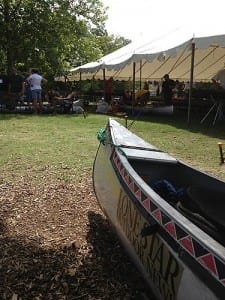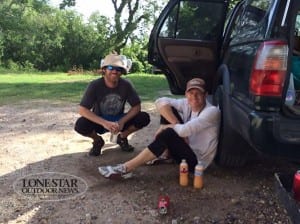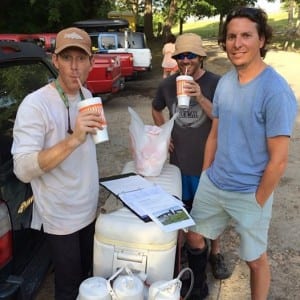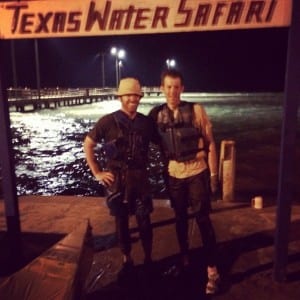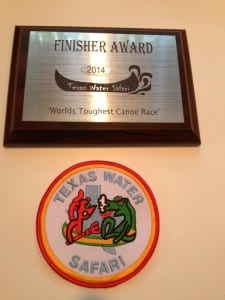LSON Managing Editor Conor Harrison, along with his paddling partner Chris Andry, completed the 260-mile Texas Water Safari in June. Here is the story.
Months of training through freezing temperatures alternating with sweltering heat, miles and miles of homogenous riverbanks, bugs, snakes and mosquitoes were about to pay off. So I hoped.
I had begun the journey in January, when a friend of mine in Dallas began talking about competing in the 260-mile long Texas Water Safari in June. He seemed as unhinged as I did, which made Chris a likely candidate to actually see the thing through and get to the finish of the event billed as “The World’s Toughest Canoe Race.”
We had run almost the entire length of the San Marcos River in training — the first time in January when temperatures hovered around the freezing mark and we paddled in waders to keep warm. We’d done 50-mile stretches of the Brazos and Trinity River in Dallas, pulling the boat through miles of low-water spots, often paddling through mounds of floating garbage, dead carp and anything else that washes into the brown water from the Metroplex. We’d trained for the end of the race across San Antonio Bay by paddling across Lake Ray Hubbard and Ray Roberts during high winds.
We’d competed in the Texas River Marathon in May — a 35-mile “sprint” from Cuero to Victoria — that determined starting positions for the big race. We had been blown away at the start of that race, but recovered nicely with our steady approach and finished in 61st place out of about 100 boats. Not bad for our first competitive canoe race. We’d be starting the TWS in the tenth row, which really made no difference, since starting position for a 260-mile, 4-day paddle doesn’t mean a whole lot.
The actual morning of the race found us sitting in our 17-foot Alumacraft canoe in Aquarena Springs at the head of the San Marcos River. This area is usually off-limits to any kind of boat, but the center makes an exception for this race.
After a hug and kiss from my wife and daughter at the dock, and last minute instructions for our team captains, Bobby and Marcus, and few warmup strokes, it was go-time. The gun went off at 9 a.m. and 101 boats, ranging in size from small one-man kayaks to long, thin six-man boats, sprinted for the first portage about a half-mile downriver. It would be one of about a dozen portages we would have to traverse the first day over dams, roads and low-water crossings.
Within 10 minutes of our first paddle stroke the rain started. It wasn’t a hard rain, but it was enough to get us wondering how wet we would be the entire trip. It turned out to be the only rain we would see, and the cloud cover throughout the first day kept temperatures about 10 degrees lower than normal — a big blessing.
Our first checkpoint was Staples Dam, 16 miles downriver. We blew through Staples at 12:30, changed water jugs with our team captains and headed for Luling. We were familiar with this stretch of river, so the tight rapids and current trying to sweep us into fallen trees weren’t a surprise.
Even so, one innocent looking rapid turned into a full-on capsizing when we hit a rock located right below the surface, turned 90 degrees and immediately filled up with water. A quick dumping on the shore and we were on our way, but not before watching two other boats do the same thing right behind us.
We hit the Highway 90 checkpoint in Luling about 5:30 p.m., had a quick rest and were back in the canoe 15 minutes later and headed downriver to Palmetto State Park.
The trip to Palmetto was uneventful and our nighttime training runs really came in handy. We paddled into the checkpoint just before midnight, where our team captains had a hot meal ready. After eating dinner consisting of grilled chicken and some salad, we got back in the boat and continued downriver.
We’d mapped out our first 24 hours before the race, so we followed the plan and pulled over to a sandy beach and stretched out for two hours. It was hard to fall asleep with boats coming by every 15 minutes or so, but to lay down flat was very helpful. We got up, stretched out and got back in the canoe about 5:30 a.m.
Neither one of us felt very good. We had paddled about 75 miles, and although neither one of us wanted to say anything, Chris and I were both thinking we might be in over our heads. That thought was magnified when we came around a corner at first light and saw a big logjam blocking the entire river. One solo race competitor was trying to get her (very big) boat up the bank and around the jam. We found a spot to get by the other boat, pulled our canoe out and carried/drug it around the logjam, through the woods and back into the river about 100 yards downstream.
At this point, I was at my lowest point physically and mentally of the entire race. Each stroke was a struggle and I was nauseous. I needed something good to happen to pick me up. Like an answer to a prayer, the San Marcos River merged with the Guadalupe River around the next turn and it was exactly what we needed. We knew we were close to the Gonzales checkpoint.
I felt the tiredness leaving my body, and over the span of about a minute, the nauseous feeling went away, the paddle strokes picked up and we were both back in the game mentally and physically.
A quick portage around the Gonzales Dam and we paddled into the checkpoint just in time for breakfast. We spent about 30 minutes in Gonzo, 85 miles into the race. We got rehydrated and mentally ready for the 36.8-mile paddle to the Hocheim 83 checkpoint. We were 24 hours into the race and following our plan to within an hour. It had been a good start.
Day two was one long, boring blur. Paddle stroke after paddle stroke, we headed down the slow-moving Guad into a brutal headwind. We arrived at Hocheim around 8 p.m. Sunday evening. After a bite to eat and refilling our water supply, we were headed to Cheapside. Our plan was to get through the Cheapside checkpoint, 24.8 miles downriver, before finding a place to rest for a couple of hours. The paddle to Cheapside would be memorable.
About midnight, I was dead tired. Each dark tree along the riverbank began to take on shapes and faces. We had heard about the hallucinations that this race can produce in people, and it was on full display this night. Laughing people, old people, young people — they all said hi to me from the trees that night. The craziest visuals were when we turned a corner and saw a boat several hundred yards in front of us. This boat had big LED lights mounted on the front of the boat (unlike the two Mag lights we had screwed to our bow), casting light high up both sides of the riverbank.
“What are those apartment buildings doing up there?” Chris asked. It did look like rows of white buildings on either side of the river. The hallucinations were getting stronger.
Just before 2 a.m., we rowed into the Cheapside checkpoint. We wasted little time here — it was only 14 miles to the next checkpoint in Cuero, so we said goodnight to our captains and went another couple of miles downriver before finding a spot to sleep. We found a good sand beach and promptly passed out. The alarm clock came as a surprise two hours later. It would be the best two hours of rest I got during the race and it was needed.
Rising again about 5 a.m., we headed toward Cuero 236 — this morning feeling much better than the morning before. We pulled into Cuero and had breakfast before getting our minds right for the next challenge — a 38.6-mile paddle to the Victoria Boat Ramp.
We were familiar with this section of river from the Marathon we paddled in May, so there weren’t any surprises — just another boring day of paddle strokes into another strong headwind to complete the miles to the next checkpoint. We arrived tired and hungry at Victoria just before 8 p.m.
When we were planning this race, we purchased a lot of energy foods like granola bars, high-energy supplements and so on. I can tell you by the end of the third day, I was about sick of energy food. We ate Whataburger at the checkpoint and the ice-cold Coke might have been the best drink I’ve ever had. Seriously.
After hammering a Whatachicken sandwich, fries and Coke, we got back in the boat for what we hoped would be our last night’s paddle. We had crossed the 200-mile mark and only had 59 to go. We didn’t realize at the time just what a nightmare those 59 miles would be.
Again, we paddled into the night toward the Invista Plant checkpoint at mile 231. We stuck to our plan and at 2:30 a.m., again pulled over to rest on a small beach. Rolling into a ball on my sleeping mat, I had a fitful two hours of rest before rising just before daylight and continuing toward the plant.
We had told Bobby and Marcus to meet us at the checkpoint at 7 a.m., but watch our SPOT Tracking device, as we could be earlier than that. We pulled into the checkpoint at 6 a.m. to hoards of mosquitoes and no captains anywhere to be seen. I almost had a heart attack when I stepped onto the bank and put my foot right next to a rattlesnake — a FAKE rattlesnake, courtesy of the volunteers working the checkpoint. Turns, out, they put those damn things all over the area — Not cool when you’ve had three hours of sleep in three days. They thought it was hilarious.
While waiting and wondering about our captains and our breakfast, we learned one of the racers had dropped out the night before after hitting a wasp nest in the dark and getting badly stung while going through the multiple log jams we knew awaited us on the next section. Just one more thing to worry about.
After 45 minutes, our captains came rolling in — a flat tire had delayed them. We ate a quick breakfast and headed downriver for the final 33 miles.
The first logjam was pretty straightforward — a nice exit from the river, nice trail along the river, nice place to put back into the river. Things got tougher from there.
The second jam wasn’t so easy to get out over the steep banks. The 200-yard long logjam was traversed after putting the small set of wheels we had brought exclusively for this section onto the back of the canoe (everything you intend to use on the trip has to be brought in the canoe — team captains can only give you food and water). The wheels didn’t work great, but they worked well enough.
There are several ways to get through the section of logjams — actually about 5 miles in total — but the five or six sections of logs range in length from 100 yards to almost two miles. To the right side of the river, small channels of water cut through swamps. Many race veterans are familiar enough with this section to find a cut and paddle their way around the jams. We weren’t veterans and the risk of getting lost was too great for us to chance. Each year several boats lose the race because they get lost trying to shortcut the logjams.
An old jeep road runs the entire length of the section to the left of the river. Our plan was to walk the section around the jams.
We did. It was a nightmare.
We devised a system of alternating 25 steps each pulling the boat from the front. At 25 steps, the person pulling would stop and drop the canoe, while the person behind walked to the front and continued on for 25. It was brutal going with thorns, bugs and heat. Chris got bitten by something and one of his eyes began to swell. Nothing to do about it except keep paddling and see a doctor after the race.
Although it only took us about three hours to get around, it felt like 30. I was gassed as we paddled into the final checkpoint before crossing San Antonio Bay and paddling to the finish line in Seadrift.
To make matters worse, the skidplate on the bottom of the stern of the canoe had come loose. Besides adding drag in the water, it had popped a small hole in the boat and water was leaking into the canoe. We stopped one time to have a look at the problem and dump water out of the boat.
At the saltwater barrier, we turned the canoe over, dried it off and applied quick-sealing marine epoxy to the skidplate and rivets of the canoe. It looked like it would hold and we didn’t have much choice but to trust it would. We had 16 miles to go and one nasty bay to cross before the finish line.
We jettisoned anything we didn’t need anymore — sleeping mats, extra water, flashlights, gear — and headed for the bay.
The wind was picking up as we neared the bay. A gentleman who owns land near the mouth of the river was kind enough to let racers use his pavilion to gear up for the entrance into the bay — it is the only portion of the race where lifevests are mandatory.
We snapped our spray skirt over the canoe and apprehensively paddled to the mouth of the Guadalupe River.
Up until this point, Chris and I had gotten along great, but that was about to be tested in the bay. Where he had picked me up going through the log jams when I was drained, I was determined to keep him focused in the bay.
When we cleared the river it was blowing. Hard.
Two-to-three foot waves battered us as we ran to the north side of the bay before turning southeast for the run beside the Victoria Barge Canal before making the north turn into Seadrift.
The high winds and waves, along with a leaky boat, combined with a lack of sleep began to affect Chris. Many teams were walking their boats along the shore, but I was against this. We were paddling at about 2 mph, and would be walking at less than that. Chris wanted to walk. I wasn’t going to do that.
We had a pretty good argument before settling down and agreeing to continue to paddle, but near the shore in case something happened and we tipped over.
We arrived at the point of the barge canal, but still had one stretch of open water to cross before a 1-mile run down the seawall to the finish.
Darkness was approaching and we were with two other boats trying to decide the best plan of attack for the last two miles. So close, and yet so far.
I was beginning to cramp due to a lack of electrolytes. First my feet, then my legs and then my stomach muscles. I didn’t say anything to my partner — he had enough to worry about without me adding to the stress of the moment. My arms still worked fine — that’s all that mattered.
Chris was still nervous, but I talked him back into the boat. We both knew we didn’t want to be making this crossing in the dark.
We paddled like madmen across the barge canal and to the point of the seawall.
We were about 500 yards from the finish when Chris said he wanted to walk the boat to the finish along the seawall. This is perfectly within the rules and many people do this.
I was having none of it.
I (not so) politely told my partner that we had paddled this boat 259.5 miles, and if he wanted to walk the boat to the finish, he could swim to shore and meet me. We were paddling this boat to the end and it was not up for discussion.
The several hundred people waiting on shore for us to finish must have wondered what the two guys in our boat were screaming about as we paddled into the finish.
As soon as we hit the dock, it was hugs all around and apologies for the argument — we had made it and the past few hours were immediately forgotten.
Someone put a cold beer in one hand and a finisher’s plaque and patch in the other. It was a great moment.
We met other teams we’d been close to the past couple of days and talked about this year’s course. After a quick shower, another beer and loading the boat and gear onto the car, our team captain was driving us back to Dallas.
We had arrived at 9:25 p.m. — exactly 84 hours and 25 minutes after we began. We finished 61st overall (the same exact spot we finished in the Marathon) and 4th in the Novice class. Our final time was within an hour of where we had planned to finish.
Looking back, we could have gone faster, but not knowing anything about the race, we were glad we took our time and rested each night.
Will I ever do it again? Maybe, but not next year. And if I do it again, I’m thinking about doing it solo. To put in the time to train and run this race again, I need a different challenge. Paddling solo is an obvious next step.
But that’s another story for another day.
I’ve looked at the patch every day since the race. It’s a constant reminder of setting a goal, however ridiculous it might seem, and seeing it through to completion.
I’ve completed the Texas Water Safari — it’s reward enough just to be able to say those words.
(Photos by Ashley Landis, Conor Harrison and Chris Andry)


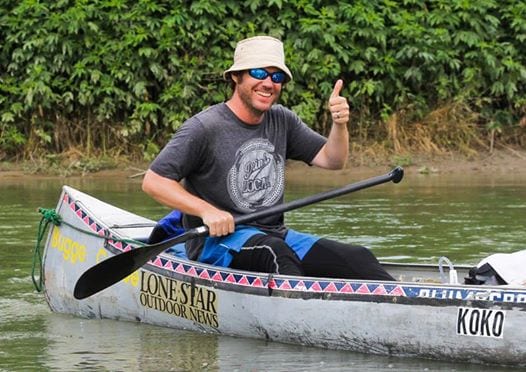
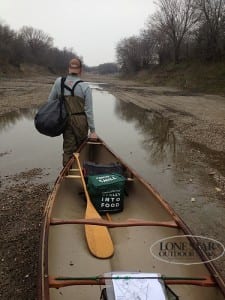
![photo[2]](https://www.lsonews.com/wp-content/uploads/2014/07/photo2-300x224.jpg)
